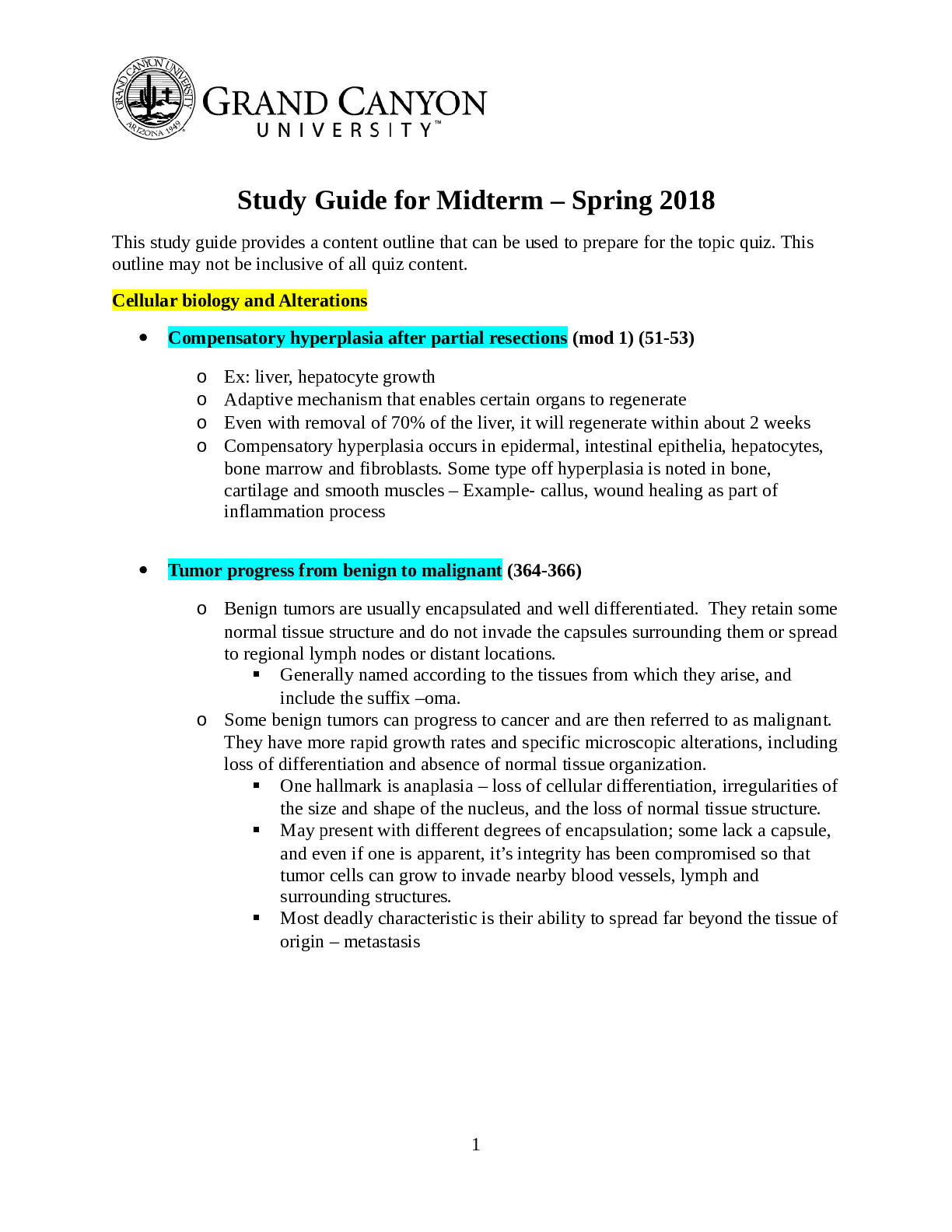This study guide provides a content outline that can be used to prepare for the topic quiz. This
outline may not be inclusive of all quiz content.
Cellular biology and Alterations
Compensatory hyperplasia after partial resections (mod 1) (51-53)
o Ex: liver, hepatocyte growth
o Adaptive mechanism that enables certain organs to regenerate
o Even with removal of 70% of the liver, it will regenerate within about 2 weeks
o Compensatory hyperplasia occurs in epidermal, intestinal epithelia, hepatocytes,
bone marrow and fibroblasts. Some type off hyperplasia is noted in bone,
cartilage and smooth muscles – Example- callus, wound healing as part of
inflammation process
Tumor progress from benign to malignant (364-366)
o Benign tumors are usually encapsulated and well differentiated. They retain some
normal tissue structure and do not invade the capsules surrounding them or spread
to regional lymph nodes or distant locations.
Generally named according to the tissues from which they arise, and
include the suffix –oma.
o Some benign tumors can progress to cancer and are then referred to as malignant.
They have more rapid growth rates and specific microscopic alterations, including
loss of differentiation and absence of normal tissue organization.
One hallmark is anaplasia – loss of cellular differentiation, irregularities of
the size and shape of the nucleus, and the loss of normal tissue structure.
May present with different degrees of encapsulation; some lack a capsule,
and even if one is apparent, it’s integrity has been compromised so that
tumor cells can grow to invade nearby blood vessels, lymph and
surrounding structures.
Most deadly characteristic is their ability to spread far beyond the tissue of
origin – metastasis
1
BENIGN TUMORS MALIGNANT TUMORS
Grow slowly
Have a well-defined capsule
Are not invasive
Are well differentiated; look like the tissue
from which they arose
Have a low miotic index; dividing cells are
rare
Do not metastasize
Grow rapidly
Are not encapsulated
Invade local structures and tissues
Are poorly differentiated; may not be able to
determine the tissue of orgin
High miotic index; many dividing cells
Can spread distantly; often through blood
vessels and lymphatics
Genetics
Recurrence of autosomal diseases (152-154, 155-156)
o Autosomal dominant - Affected offspring are produced by the union of a normal
parent with an effected heterozygous parent
Affected parent can pass either a disease gene or a normal gene to his or
her children
Each event has a probability of 0.5, so on average half the children will be
normal and half will express the disease.
o Autosomal recessive – individual must be homozygous for a recessive allele to
express the disease – can survive the population one generation to the next
Characterized by delay of onset, incomplete penetrance, and variable
expressivity – most common is cystic fibrosis
Recurrence risk for the offspring of carrier parents is 25%
Klinefelter’s syndrome (mod 1) (148, 156, 914)
o Causes
Chromosomal disorder XXY – genotype
Genetically male – due to Y
Male XY, female XX
Random, not inherited – nondisjunction in the X chromosomes in the
mother
o Signs and Symptoms
Both male and female sexual characteristics
Decreased T more female hormones causing
Less body and facial hair
Gynecomastia (risk breast CA) Weak muscles and bones (osteoporosis), shy (tall, lanky, shy)
Can result in decreased IQ
Higher risk of AI disorders
Majority - Infertility
Read More


